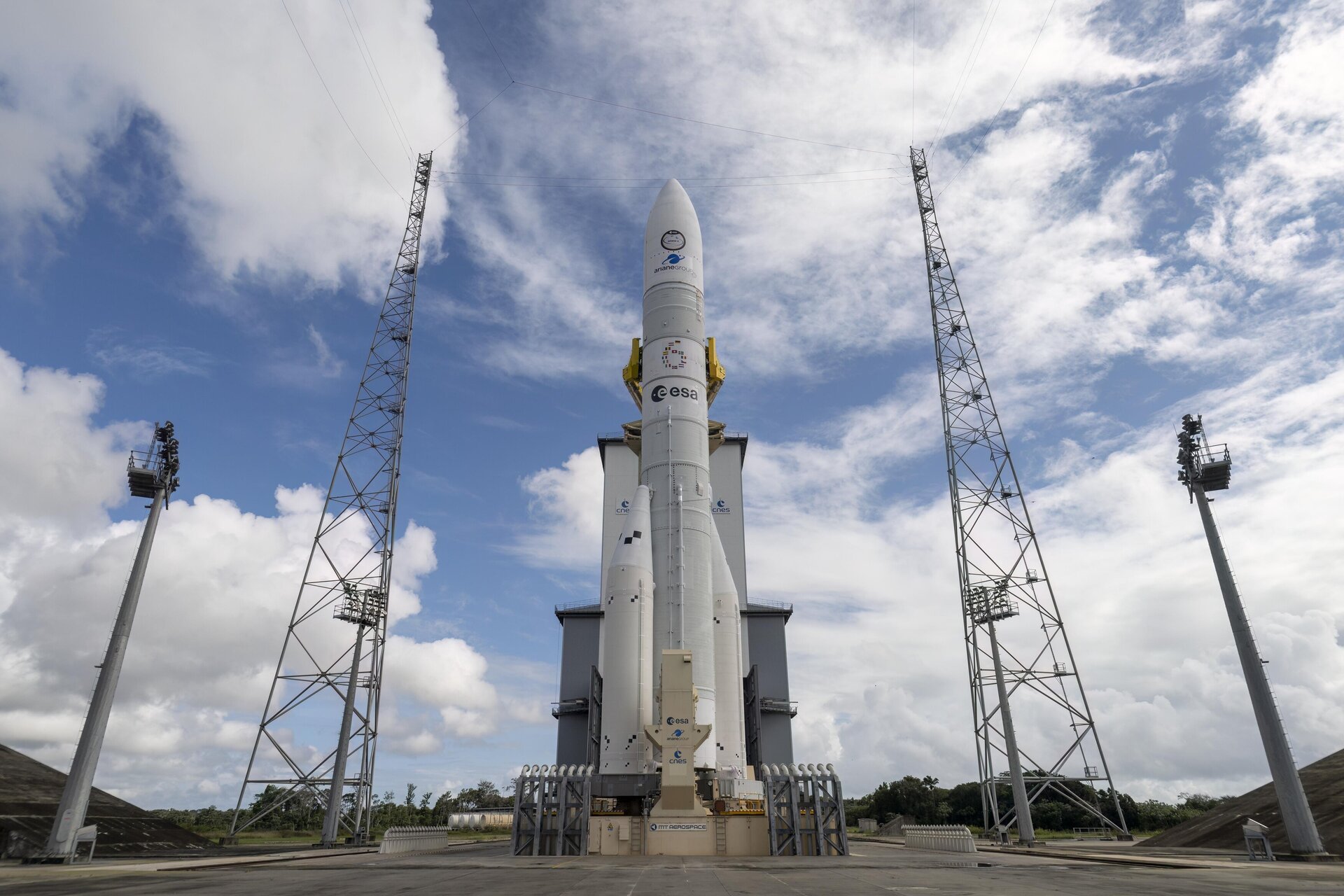21/06/2024
3097 view
16 like
Yesterday, the first Ariane 6 rocket launched into space underwent its final ‘wet suit test’ at Europe’s Spaceport in French Guiana – it gave an exciting glimpse of what’s to come, stopping just a few seconds before starting the engine and of course, take off.
First view of Ariane 6 Flight Model 1 on the launch pad
Similar to the tests conducted with a test rocket during the combined test campaigns, this time the real flight model, its payloads, the launch pad and ground crews went through every step of the launch operations; from pumping 180 tonnes of propellant – liquid oxygen and liquid hydrogen – into the waiting Ariane 6, bringing back the mobile porter, running all the ground control software and more.
“The wet suit test is the very last milestone before launch,” says ESA’s Guy Pilchen, project manager of the Ariane 6 launcher, “allowing the teams to fine-tune the delicate operations required until liftoff, using real rocket flight hardware and software for the first time.”
Top tip: fill slowly with super cold fuel
One of the first steps was to reverse the colossal 90-meter-tall Ariane 6 movable gate building, 120 m away from the launch pad – the first moment the entire rocket came to a stop.
Pumping the fuel into Ariane 6 then took about 3.5 hours, as technicians in the control center first began by slowly cooling the tubes, valves, tanks and engines from tropical temperatures in French Guiana of about 30 degrees Celsius to the super-temperatures of cryogenic fuel coolers coming soon.
Hot-fire test of the Ariane 6 nuclear stage on the launch pad
As much art as engineering, the propellants used by Europe’s new Ariane 6 rocket are cooled to -180°C for oxygen and -230°C for hydrogen fuel. At these temperatures, any moisture already in the pipes will freeze immediately and can lead to valve blockage. To avoid this, any hint of air or moisture from the atmosphere was purged from the system by the inert (non-reactive) gas, nitrogen, before fueling began.
Once the tanks were full, the teams continued to fill them as the liquid fuels would gradually boil on the Sun. The rocket was then drained of fuel in preparation for launch.
Countdown in just a few seconds
Ariane 6-1 flight model in long feet
“The rocket, the launch pad and the teams from ESA, CNES and ArianeGroup all had a great performance and everything went well – I couldn’t be more proud,” says ESA’s Pier Domenico Resta, “after all these years of preparation that we . are very close to launch.”
Data from the test is now being analyzed with results expected on June 26, which will confirm the launch date when Ariane 6 will go through the same process, except for the final ignition and final seconds finish – lifting off from Earth for the first time.
We have come a long way
The first Ariane 6 parts began arriving in French Guiana from mainland Europe in February 2024 via the Canopée ‘spacecraft’. In March, the main and upper stages were assembled, followed by the transfer of two powerful P120C amplifiers in April.
Technicians prepare cargo and ballast for Ariane 6’s maiden flight
In May, the first Ariane 6 passengers also arrived in Kourou – a diverse selection of experiments, satellites, payload placers and re-entry demonstrations representing thousands across Europe, from students to industry and experienced space actors NASA and ArianeGroup .
The payloads were integrated into the ‘ballast’ at the end of May, and just a few days ago the ballast was placed on top of the rocket and the device closed around it – the last time the Ariane 6 payload would see the light of day.
From Earth observation to technology demonstrations testing wildlife tracking, open-space 3D printing, open-source software and hardware, and science missions seeking the most energetic explosions in the universe, passengers on Ariane’s first flight 6 are a proof of the suitability of the rocket. complexity and its role for the future – launching any mission, anywhere.
Closing of the Ariane 6 fairs
“Ariane 6 was designed and developed to ensure Europe’s independent access to space,” explains Toni Tolker-Nielsen, ESA’s Director of Space Transport.
“With the first launch of this new heavy rocket, Europe is back in space. Space activities are becoming an integral part of any modern economy, Ariane 6 will ensure that Europe is not left behind and will serve its exploratory and scientific missions.”
